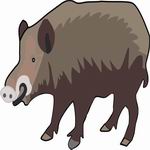- The wild boar is found in Europe, Asia, and parts of North Africa.
- The boar can live in groups up to fifty.
- The wild boar's mating season takes place during the winter months.
- The boar can have two to twelve babies in a litter.
- They are born usually between March and May.
- The piglets are not full grown until the age of four or five years.
- The wild boar is found in the coniferous forest and in the grassland.
- It builds its home in thickets and tall grass.
- The boar does not hibernate, nor does it migrate.
- Some of the wild boar's special adaptations are its tusks and its
snout.
- The tusks are used for protection from its predator.
- The snout is used for digging up soil so it can eat roots and plant
bulbs.
- The wild boar also has been hunted for many years.
- The Wild Boar (Sus scrofa) is the ancestor of the domestic pig.
- Its weight can reach up to 300 kilograms!
- Although 'boar' usually means male pig, the Wild boar is the name
of the species. The males have both upper and lower tusks, while females
have none. When in a group of pig, the pigs are called 'sounders'
- Before the invention of synthetic fibers, toothbrushes were made from
the hair on the back of a boar, although they contained lots of bacteria.
- The fetal pig (Sus scrofa) is a popular mammalian dissection specimen
because of its size and low cost.
- The Wild Boar (Sus scrofa) is called Jungli Suar in Hindi.
- The shield of the wild boar is his protection from the tusks of his
adversaries.
- Wild boars are large - sometimes 5 feet long, and weigh up to 300
pounds.
- Wild boars are wandering the hills in Bloomville, according to several
residents in the Scotch Hill Road area, but officials don't seem to
have any jurisdiction over the animals.
|


